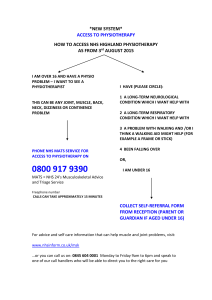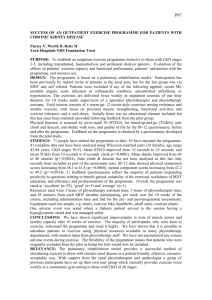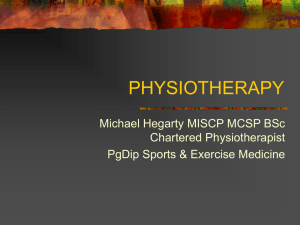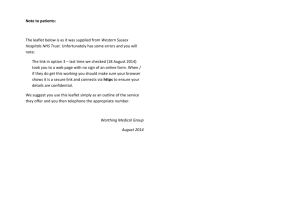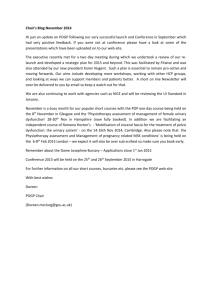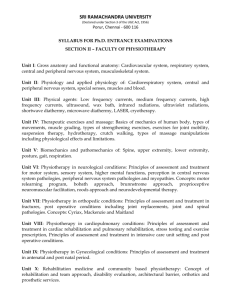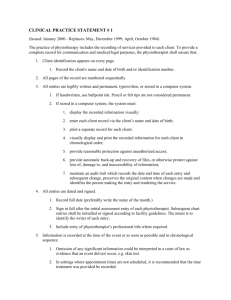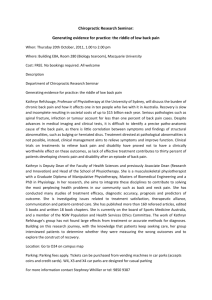here - critical physiotherapy network
advertisement
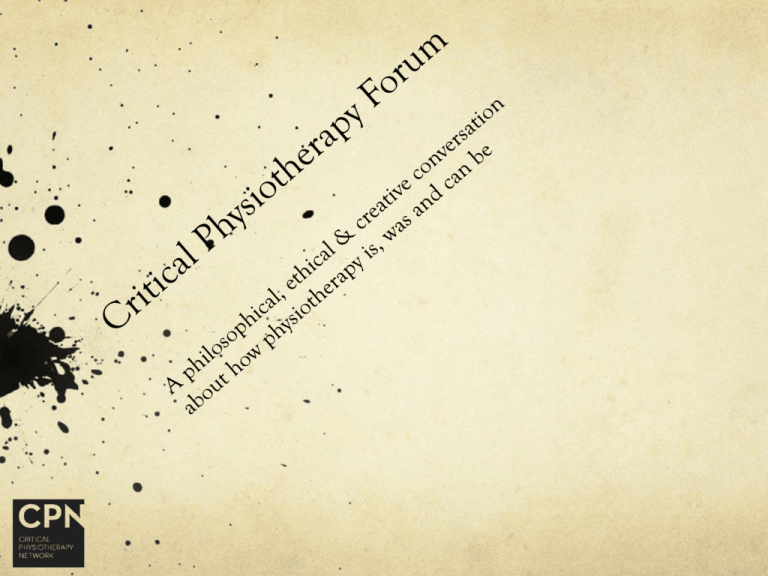
Acknowledgement of country Critical physiotherapy challenges contemporary physiotherapy theory & practice works towards a more positive, inclusive, critical future for physiotherapy Speakers Dr Ian Edwards What is the source of our ethical obligation in physiotherapy practice: Codes of Conduct or the Levinasian face? Amy Hiller ‘Insider’ research: Reflexivity as a tool to manage participant misconceptions. Blaise Doran A physiotherapist prepares: Enhancing the therapeutic alliance through Psychological Realism acting methods. Dr Gwyn Owen Thinking through the body: embodiment as a conceptual framework for researching what physiotherapy was, is and can be. A/Prof David Nicholls Physiotherapy as exotic abstraction: The role of luxury and surplus in the genealogy of a profession. Speakers Dr Ian Edwards What is the source of our ethical obligation in physiotherapy practice: Codes of Conduct or the Levinasian face? What is the source of our ethical obligation in physiotherapy: Codes of conduct or the Levinasian face? Ian Edwards Ethics in physiotherapy sits on a fault line Codes of conduct: Regulation of professional behaviour and practice standards To be caring and have compassion Delany et al (In preparation) Josephson et al 2015 Emmanuel Levinas Ethics as 1st philosophy Alterity – the primacy of the ‘other’ The Levinasian ‘face’ (Levinas 1969 p 66) The boy with no eyes From Edwards, I. The boy with no eyes – an ethics of ourselves with others. (In preparation) Edwards et al 2014 references Delany C, Edwards I & Fryer C. Ethical dimensions of Australian physiotherapy practice (In preparation). Edwards I. The boy with no eyes – an ethics of ourselves with others. (In preparation) Edwards I, Jones M, Thacker M, & Swisher LL. 2014. The Moral Experience of the Patient with Chronic Pain: Bridging the Gap Between First and Third Person Ethics. Pain Medicine 15: 364–378 Josephson I, Woodward-Kron R, Delany C & Hiller A. 2015. Evaluative language in physiotherapy practice: How does it contribute to the therapeutic relationship? Social Science and Medicine 143:128-136 Levinas E 1969. Totality and Infinity: an essay on exteriority. Trans. Alphonso Lingis. Pittsburgh, Pennsylvania; Duquesne University Press, p 66. Speakers Dr Ian Edwards What is the source of our ethical obligation in physiotherapy practice: Codes of Conduct or the Levinasian face? Amy Hiller ‘Insider’ research: Reflexivity as a tool to manage participant misconceptions. Blaise Doran A physiotherapist prepares. Dr Gwyn Owen Thinking through the body: embodiment as a conceptual framework for researching what physiotherapy was, is and can be. A/Prof David Nicholls Physiotherapy as exotic abstraction: The role of luxury and surplus in the genealogy of a profession. Speakers Amy Hiller ‘Insider’ research: Reflexivity as a tool to manage participant misconceptions. ‘Insider’ research: reflexivity as a tool to manage participant misconceptions Amy Hiller The University of Melbourne Contact: a.terry@student.unimelb.edu.au Who am I? What is my identity? Health care professional/ clinician/Physiot herapist Researcher - Dual clinician-researcher identity - ‘insider-researcher’ (Allen, 2004; Asselin, 2003) How do I consider what my role is? Reflexivity • • - Involves “disciplined self–reflection” Self-awareness, critical evaluation Consideration of role and impact on research Benefits: Enhances rigor and reduces bias Provides guidance to manage ‘ethically important moments’ (Doyle, 2013; Finlay, 2002; Guillemin and Gillam, 2004; Johnson and Waterfield, 2004) What are my role identities? Health care professional/Physiotherapist - Caring and helping nature - Patient advocate - Influenced by professional socialization - Focus on providing a service of patient care Researcher - Investigational - Objectivity - Focus on generating knowledge and understanding (Colbourne & Sque, 2004) The clinician-researcher • Dual role or ‘insider researcher’ Benefits - Easier access to participants for recruitment Easier development of rapport with participants Familiarity with clinical environment and terminology - Challenges Managing the different focuses of the roles Understanding scope and boundaries of each role Managing misconceptions of participants Ethical challenges (Allen, 2004; Asselin, 2003; Colbourne and Sque, 2004; Reed and Proctor, 1995) Considerations The therapeutic misconception in quantitative research Clinical trials research participants: • Confuse participation with personalized care • Do not appreciate random assignment to treatment • Expect direct benefit Ethical and methodological issues can arise (Appelbaum et al., 2004; Dresser, 2002; Glannon, 2006; Miller and Joffe, 2006; Townsend et al., 2010) Participant misconceptions in qualitative research Patient-participants: • Feeling an obligation to participate • Expecting treatment Practitioner-participants: • Expecting to receive feedback • Perception of being judged (Hiller and Vears, 2016 – in press) Conclusion • The insider-researcher must be aware of his or her role regarding potential misconceptions of participants • Reflexivity is critical to achieving this awareness • Helpful tips: • Be aware of the potential for misconceptions • Talk to other researchers to gain different perspectives • Keep a research diary Thank you a.terry@student.unimelb.edu.au References Allen, D. (2004), “Ethnomethodological insights into insider-outsider relationships in nursing ethnographies of healthcare settings”, Nursing Enquiry, Vol. 11 No. 1, pp. 14-24. Appelbaum, P. S., Lidz, C. W. and Grisso, T. (2004), “Therapeutic misconception in clinical research: Frequency and risk factors”, IRB: Ethics and Human Research, Vol. 26 No. 2, pp. 1-8. Asselin, M. E. (2003), “Insider research: Issues to consider when doing qualitative research in your own setting”, Journal for Nurses in Staff Development, Vol. 19 No. 2, pp. 99- 103. Colbourne, L., & Sque, M. (2004). Split personalities: role conflict between the nurse and the nurse researcher. NT Research, 9(4), 297-304. Doyle, S. (2013), “Reflexivity and the capacity to think”, Qualitative Health Research, Vol. 23 No. 2, pp. 248-255. Dresser, R. (2002), “The ubiquity and utility of the therapeutic misconception”, Social Philosophy and Policy, Vol. 19 No. 2, pp. 271–294. Finlay, L. (2002). "Outing" the researcher: The provenance, process, and practice of reflexivity. Qualitative Health Research, 12(4), 531-545. Glannon, W. (2006), “Phase I oncology trials: Why the therapeutic misconception will not go away”, Journal of Medical Ethics, Vol. 32 No. 5, pp. 252-255. Guillemin, M. and Gillam, L. (2004), “Ethics, reflexivity, and 'ethically important moments' in research”, Qualitative Inquiry, Vol. 10 No. 2, pp. 261-280. Hiller, A. and Vears, D (2015), “Reflexivity and the clinician-researcher: managing participant misconceptions”, Qualitative Research Journal (In Press). Johnson, R. and Waterfield, J. (2004), “Making words count: the value of qualitative research”, Physiotherapy Research International, Vol. 9 No. 3, pp. 121-131. Miller, F. G. and Joffe, S. (2006), “Evaluating the therapeutic misconception”, Kennedy Institute of Ethics Journal, Vol. 16 No. 4, pp. 353-366. Reed, J. and Procter, S. (1995), “Practitioner research in context”, in Reed, J. and Proctor, S. (Eds.), Practitioner research in health care: The inside story, Chapman and Hall, London, pp. 3-31. Townsend, A., Cox, S. M. and Li, L. C. (2010), “Qualitative research ethics: Enhancing evidence-based practice in physical therapy”, Physcial Therapy, Vol. 90 No. 4, pp. 615-628. Speakers Dr Ian Edwards What is the source of our ethical obligation in physiotherapy practice: Codes of Conduct or the Levinasian face? Amy Hiller ‘Insider’ research: Reflexivity as a tool to manage participant misconceptions. Blaise Doran A physiotherapist prepares: Enhancing the therapeutic alliance through Psychological Realism acting methods. Dr Gwyn Owen Thinking through the body: embodiment as a conceptual framework for researching what physiotherapy was, is and can be. A/Prof David Nicholls Physiotherapy as exotic abstraction: The role of luxury and surplus in the genealogy of a profession. Speakers Blaise Doran A physiotherapist prepares: Enhancing the therapeutic alliance through Psychological Realism acting methods. A physiotherapist prepares • Psychological Realism Enhancing the therapeutic alliance through Realism acting methods. • Psychological Events • Objectives and Actions • Putting it to use; questions Blaise Doran, BSc Physiotherapy, Grad. Dip. Neuro. Rehab. “Psychological Realism” in acting. Konstantin Stanislavsky (1863 – 1938) Maria Knebel (1898 - 1985) Sam Kogan (1946 – 2004) Kogan,“Psychological S [Ed. Kogan,Realism” H] (2010). TheThe Science of Acting, AKA Method Routledge, UK. Events That which intensifies our thinking or Intensified thinking itself (Kogan, 2010) Intensity of thought y Physiotherapy Anticipation Dissipation C B T Circumstance t=n Events ≠ physical happenings x Objectives and Actions (Purposes) Purposes (long term) Super-purpose Objectives (short or medium term) Objective Birth Death Value oriented / goal oriented. Purposes & objectives: Happiness: Actions: A want; a change we want to fulfil Achieving purposes… What we do to achieve our purpose. Putting it together Intensity of thought y Accident Objectives What is the want driving them to see you? Anticipation Egotistical objective – wanting to change the thinking ofPanother H person Y own Altruistic objective – a thought you want to achieve in your Dissipation Afterburn S head. I Can complementary you teach empathy? Are your objectives (collectively) or O contradictory? Questions: W Actions 1 2 doing What are they to3 Does a formula lead to failure? try to 4 achieve t = months Thought physical behaviour 5 objective? 6 their C x Speakers Dr Ian Edwards What is the source of our ethical obligation in physiotherapy practice: Codes of Conduct or the Levinasian face? Amy Hiller ‘Insider’ research: Reflexivity as a tool to manage participant misconceptions. Blaise Doran A physiotherapist prepares: Enhancing the therapeutic alliance through Psychological Realism acting methods. Dr Gwyn Owen Thinking through the body: embodiment as a conceptual framework for researching what physiotherapy was, is and can be. A/Prof David Nicholls Physiotherapy as exotic abstraction: The role of luxury and surplus in the genealogy of a profession. Speakers Dr Gwyn Owen Thinking through the body: embodiment as a conceptual framework for researching what physiotherapy was, is and can be. Thinking through the body: embodiment as a conceptual framework for researching what physiotherapy was, is and can be Gwyn Owen PhD MCSP Background research developed in response to gaps in the literature about the evolution of physiotherapy practice and the uncertainty emerging from within UK physiotherapy during 2000s about its identity and practices bodies of physiotherapists experiencing and producing physiotherapy appeared to be an absent presence within the literature genealogical study of existing literature, documentary data from physiotherapy’s qualifying curricula and oral accounts of practice generated by physiotherapists who qualified during the 1940/60s. Embodiment… is about the interplay between the body and the world the body lives in challenges physiotherapy’s dualistic mode of thinking about the body and bodily practices understands the body to be a dynamic interface for exploring discursive practices, lived experiences and ways of being and doing Method/ology Genealogical approach Data generated from national physiotherapy qualifying curricula and depth interviews with 12 physiotherapists who had qualified during 1940/60s professionalising bodies 1928 1930/40s 1950s 1960s 1977 1991 2015 conclusion Embodiment offers a conceptual framework for uncovering relationships between physiotherapy’s identity (being) and practice (doing). For example: - what physiotherapists’ bodies can do in a given time/place - how physiotherapists/clients/technologies work together to produce physiotherapy’s identities/practices - how physiotherapy’s identities/practices multiply as it moves through space and time prompts for a conversation …We all have and are a body. But there is a way out of this dichotomous twosome. As part of our daily practices, we also do (our) bodies. In practice we enact them. If the body we have is the one known by pathologists after our death, while the body we are is one we know ourselves by being self aware, then what about the body we do? What can be found out and said about it? Is it possible to inquire into the body we do? And what are the consequences if action is privileged over knowledge? Mol & Law, 2004. Body and Society 10(2-3)43-62 pp45 Speakers Dr Ian Edwards What is the source of our ethical obligation in physiotherapy practice: Codes of Conduct or the Levinasian face? Amy Hiller ‘Insider’ research: Reflexivity as a tool to manage participant misconceptions. Blaise Doran A physiotherapist prepares. Dr Gwyn Owen Thinking through the body: embodiment as a conceptual framework for researching what physiotherapy was, is and can be. A/Prof David Nicholls Physiotherapy as exotic abstraction: The role of luxury and surplus in the genealogy of a profession. Speakers A/Prof David Nicholls Physiotherapy as exotic abstraction: The role of luxury and surplus in the genealogy of a profession. Archives Archives New Zealand Alexander Turnbull Library National Library of New Zealand Papers Past digital archive Sampling strategy Primary sources Published/unpublished manuscripts Period newspapers Personal accounts Legislation Institutional records Oral histories Correspondence Registers and directories Photographs Secondary texts Existing histories Search terms balneo*, exercis*, hauwai, waiariki, ngawha, masseu*, mirimiri, “Swedish movement cure”, gymnastics AND correct*, electrotherap*, health AND physical, “hot springs” Settler practices “Ankles, Weak—Treatment: Bathe in sea water; wear lace boots…use friction at time of bathing.” “Asthma—Treatment: Inhale chloroform; smoke from brown paper—Stramonium cigarettes; blotting paper, soaked in strong solution of nitre, dried, and fumes inhaled. If no Bronchitis, give twenty or thirty drops of laudanum.” “Bite of dog—Treatment: Immediately suck the wound and apply caustic; if dog is certainly mad, part should be cut out and washed with vinegar and water, or burnt with a hot iron.” A few isolated practitioners Argument Physical therapies v popular in Europe and N America in C19th No evidence of any PTs in NZ at same time – no luxury or surplus time/money Māori PTs decimated, settlers too isolated for public services, atomistic, self-reliant – “just get on with it” Took political action after 1890 and then birth of welfare state to make physio possible Is physio dependent on luxury and surplus? Not if there is a welfare state…but what happens now welfare state is being dismantled? Will PT become a profession only for those who can afford it? Speakers – Questions? Dr Ian Edwards What is the source of our ethical obligation in physiotherapy practice: Codes of Conduct or the Levinasian face? Amy Hiller ‘Insider’ research: Reflexivity as a tool to manage participant misconceptions. Blaise Doran A physiotherapist prepares. Dr Gwyn Owen Thinking through the body: embodiment as a conceptual framework for researching what physiotherapy was, is and can be. A/Prof David Nicholls Physiotherapy as exotic abstraction: The role of luxury and surplus in the genealogy of a profession. Critical Physiotherapy Forum Panel
